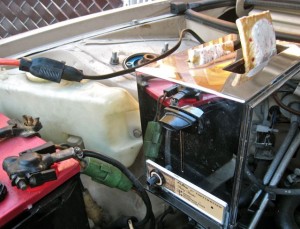 The best part about having musty old car magazines from the ’60s is reading press releases about how by 1971, we would all be driving electric cars that ran on batteries comprised of then futuristic exotic materials. In the Detroit Spotlight department of a December 1966 issue of Motor Trend magazine is a small photo of a 1931 Detroit Electric Model 99, accompanied by the news of near future Big Three electric fleets. Ford had come up with an ultra-lightweight sodium-sulphide battery pack that held the equivalent of a tank of gas, thus overcoming the problem heavy and expensive electric automobile battery packs.
The best part about having musty old car magazines from the ’60s is reading press releases about how by 1971, we would all be driving electric cars that ran on batteries comprised of then futuristic exotic materials. In the Detroit Spotlight department of a December 1966 issue of Motor Trend magazine is a small photo of a 1931 Detroit Electric Model 99, accompanied by the news of near future Big Three electric fleets. Ford had come up with an ultra-lightweight sodium-sulphide battery pack that held the equivalent of a tank of gas, thus overcoming the problem heavy and expensive electric automobile battery packs.
“Until now, batteries capable of propelling an electric car through a normal working day have either weighed around 900 pounds, or have been composed of esoteric, impossibly expensive materials…Aside from Ford, both GM and Chrysler are known to be working on electric car projects, along with alternate ‘fuel cell’ units. GM is leaning towards a lithium and air battery which is enervated in the morning simply by pouring water into it, but each night the plates have to be removed for cleaning, much like false teeth. Chrysler won’t talk about batteries, but admits that it likes the idea of putting an electric motor at all four wheels” – Motor Trend, December 1966
The mid-sixties were a regular thin-filmed nano-technology fully scalable electric car bonanza out there in Motor City! And to think that until 1966, the problem of heavy and/or expensive batteries for electric automobiles had yet to be solved. Now, if we could only harness the heat contained in a pair of freshly toasted Pop Tarts to power to the Starlet, an affordable and fortified with seven vitamins and minerals power source for sustainable and delicious motoring would be upon us.
“Chrysler won’t talk about batteries…”
Typical Chrysler – let everyone else do all the dirty work. “But, you see, we would like to put electric motors on all four wheels, but maybe one on the spare!”. I wonder how long it took them to think that up.
Time to start reading up on sodium-sulfide batteries.
So…what ever happened to the sodium sulphide? Did the EPA kill it off?
@mechimike
Sodium sulphide batteries require very high operating temperatures (around 300 degrees centigrade) and if left to go cold take about a week to heat back up before they will accept a charge. Also, they have yet to be made cheap enough to be economically feasible for mass production. Look up Zebra battery using your favorite search engine. Lots of info out there if you care to look.